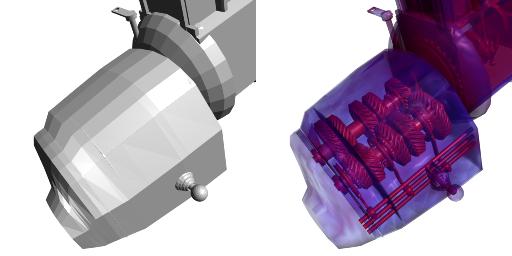
We present an algorithm for automatically classifying the interior and exterior parts of a polygonal model. The need for visualizing the interiors of objects frequently arises in medical visualization and CAD modeling. The goal of such visualizations is to display the model in a way that the human observer can easily understand the relationship between the different parts of the surface. While there exist excellent methods for visualizing surfaces that are inside one another (nested surfaces), the determination of which parts of the surface are interior is currently done manually.
Our automatic method for interior classification takes a sampling approach using a collection of direction vectors. Polygons are said to be interior to the model if they are not visible in any of these viewing directions from a point outside the model. Once we have identified polygons as being inside or outside the model, these can be textured or have different opacities applied to them so that the whole model can be rendered in a more comprehensible manner. An additional consideration for some models is that they may have holes or tunnels running through them that are connected to the exterior surface. Although an external observer can see into these holes, it is often desirable to mark the walls of such tunnels as being part of the interior of a model. In order to allow this modified classification of the interior, we use morphological operators to close all the holes of the model. An input model is used together with its closed version to provide a better classification of the portions of the original model.
A motor and its interior.
Opaque skull (left) and the skull's interior (right).
An engine turbine blade (left) and a rendering of the same model with the exterior surface made transparent (right).
Go to Greg Turk's Home Page.
Any opinions, findings, and conclusions or recommendations expressed in this material are those of the author(s) and do not necessarily reflect the views of the National Science Foundation.